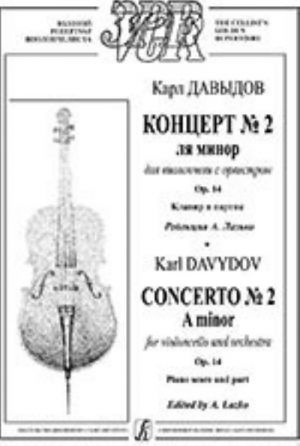Cерия "Золотой репертуар виолончелиста" ставит своей целью публикацию наиболее значительных и интересных произведений мировой виолончельной литературы, составляющих основу современного концертного и учебного репертуара. Это и крупные камерные сочинения для виолончели соло и с сопровождением фортепиано, и клавирные переложения концертов для виолончели с оркестром, а также концертные пьесы малой формы. Помимо публиковавшихся ранее и широко известных произведений сюда войдут незаслуженно забытые и новые, впервые публикуемые сочинения и транскрипции.
Основу позиции редактора в данном издании составляет стремление к гармоничному сочетанию современного исполнительского прочтения произведений с максимальным приближением к авторскому варианту. В сочинениях, находящих широкое применение в учебном репертуаре, особое внимание уделено уточнению аппликатуры с позиций современного виолончельного исполнительства.
Karl Yulyevich Davydov (1838–1889) is the distinguished Russian cellist, conductor, composer, musical figure. His activity was tightly connected with the St. Petersburg Conservatoire, where many generations of performers were bred by him during the period of 1862–1887 having been its director from 1876 to 1887.
Among Davydov’s compositions there are the symphonic poem “Terek’s Gifts”, 4 concertos for cello and orchestra, chamber-instrumental and chamber-vocal opuses, so as the Cello School.
Concerto No. 2 for Cello op. 14 A minor and Orchestra takes special place in Davydov’s heritage. It refers to 1863, embodying the best features of Davydov-composer and brilliant cellist virtuoso.
As the previous Davydov’s cello Concerto No. 1 B minor continued the tradition of B. H. Romberg (1767–1841), famous German cellist and composer, the Con-certo No. 2 op.14 manifests Mendelssohn’s and Schumann’s ideas. The themes are getting nourished with clearly recognized individual Davydov’s nature. Virtuosity ceases its abstract technical existence, being plaited to the conception itself. Orchestra’s function becomes significant in the whole dramaturgic development.
The composition is called a concerto, when it is given the true masterly cadenza, like the one evolving according to the dramaturgic outline and pouring out in the first movement of the op. 14.
Gentle lyricism, striking virtuosity and excellently wrought score make for this Concerto’s attractiveness and success at the concert stage.
Karl Yulyevich Davydov (1838–1889) is the distinguished Russian cellist, conductor, composer, musical figure. His activity was tightly connected with the St. Petersburg Conservatoire, where many generations of performers were bred by him during the period of 1862–1887 having been its director from 1876 to 1887.
Among Davydov’s compositions there are the symphonic poem “Terek’s Gifts”, 4 concertos for cello and orchestra, chamber-instrumental and chamber-vocal opuses, so as the Cello School.
Concerto № 2 for Cello op. 14 A minor and Orchestra takes special place in Davydov’s heritage. It refers to 1863, embodying the best features of Davydov-composer and brilliant cellist virtuoso.
As the previous Davydov’s cello Concerto № 1 B minor continued the tradition of B. H. Romberg (1767–1841), famous German cellist and composer, the Con-certo № 2 op.14 manifests Mendelssohn’s and Schumann’s ideas. The themes are getting nourished with clearly recognized individual Davydov’s nature. Virtuosity ceases its abstract technical existence, being plaited to the conception itself. Orchestra’s function becomes significant in the whole dramaturgic development.
The composition is called a concerto, when it is given the true masterly cadenza, like the one evolving according to the dramaturgic outline and pouring out in the first movement of the op. 14.
Gentle lyricism, striking virtuosity and excellently wrought score make for this Concerto’s attractiveness and success at the concert stage.
Cerija "Zolotoj repertuar violonchelista" stavit svoej tselju publikatsiju naibolee znachitelnykh i interesnykh proizvedenij mirovoj violonchelnoj literatury, sostavljajuschikh osnovu sovremennogo kontsertnogo i uchebnogo repertuara. Eto i krupnye kamernye sochinenija dlja violoncheli solo i s soprovozhdeniem fortepiano, i klavirnye perelozhenija kontsertov dlja violoncheli s orkestrom, a takzhe kontsertnye pesy maloj formy. Pomimo publikovavshikhsja ranee i shiroko izvestnykh proizvedenij sjuda vojdut nezasluzhenno zabytye i novye, vpervye publikuemye sochinenija i transkriptsii.
Osnovu pozitsii redaktora v dannom izdanii sostavljaet stremlenie k garmonichnomu sochetaniju sovremennogo ispolnitelskogo prochtenija proizvedenij s maksimalnym priblizheniem k avtorskomu variantu. V sochinenijakh, nakhodjaschikh shirokoe primenenie v uchebnom repertuare, osoboe vnimanie udeleno utochneniju applikatury s pozitsij sovremennogo violonchelnogo ispolnitelstva.













